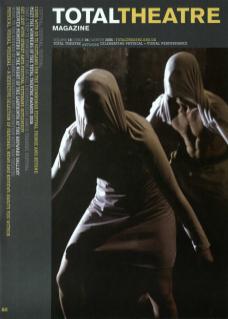A stage full of people, bloody ghosts in the machine, in limbo, or a Bardo of Becoming (or maybe Dantes’s Purgatorio), making tracks, following paths – solo, in pairs, in groups of three or more. Jarring noise-music, tremendous scenic moments of change as lights cut or a suspended curtain falls, compulsive-repetitive movement motifs, and dramatic shifts of intensity in the intensity of sound or light or mood. This epilogue to the company’s ‘invisible dances’ project (an investigation of absence and presence) feels meaningful, but meanings escape me, the memory of sensory experience (mostly of assaults to the eyes and ears) remain; the after-effects of sensation are the ghosts that haunt. What is seen and what is imagined become blurred in the unfolding dreamscape onstage.
This is the final part of a long research process, the last in a sequence of three performance pieces. It is unashamedly an art piece; reference points might include: the European tradition of dance-theatre work (Pina Bausch and Alain Platel), the industrial electronica of Einstürzende Neubauten, the butoh-inspired physical theatre of recent work by Derevo, the live art work of artists such as Stelarc. All and none of the above.
How the audience feels seems unimportant; how we are responding to these visions doesn’t seem to have any bearing on what is happening on stage. The series of moving images sometimes engages but often passes by leaving mere traces in the air. I have little real interest in the (mostly intense and angst-ridden) performing bodies in front of me: the exception is Rose English, who, dressed in an elegant black evening dress, moves on a mostly sideways or diagonal trajectory, painfully slowly, whilst reciting a repeating text which seems to change in nuance and meaning throughout the performance, but that may not be true. ‘I’d be happy just watching her all night,’ says my companion, and I can’t help but agree. Is it good? Do I like it? Questions that I can’t answer.

